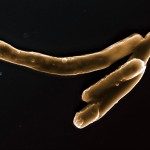Link to Pubmed [PMID] – 16092920
Biochem. J. 2005 Dec;392(Pt 3):615-24
Interactions between dendritic cells and Mycobacterium tuberculosis, the aetiological agent of tuberculosis in humans, are thought to be central to anti-mycobacterial immunity. We have previously shown that M. tuberculosis binds to human monocyte-derived dendritic cells mostly through the C-type lectin DC-SIGN (dendritic-cell-specific intercellular molecule-3-grabbing non-integrin)/CD209, and we have suggested that DC-SIGN may discriminate between mycobacterial species through recognition of the mannose-capping residues on the lipoglycan lipoarabinomannan of the bacterial envelope. Here, using a variety of fast- and slow-growing Mycobacterium species, we provide further evidence that mycobacteria recognition by DC-SIGN may be restricted to species of the M. tuberculosis complex. Fine analyses of the lipoarabinomannan molecules purified from these species show that the structure and amount of these molecules alone cannot account for such a preferential recognition. We propose that M. tuberculosis recognition by DC-SIGN relies on both a potential difference of accessibility of lipoarabinomannan in its envelope and, more probably, on the binding of additional ligands, possibly including lipomannan, mannose-capped arabinomannan, as well as the mannosylated 19 kDa and 45 kDa [Apa (alanine/proline-rich antigen)] glycoproteins. Altogether, our results reveal that the molecular basis of M. tuberculosis binding to DC-SIGN is more complicated than previously thought and provides further insight into the mechanisms of M. tuberculosis recognition by the immune system.

